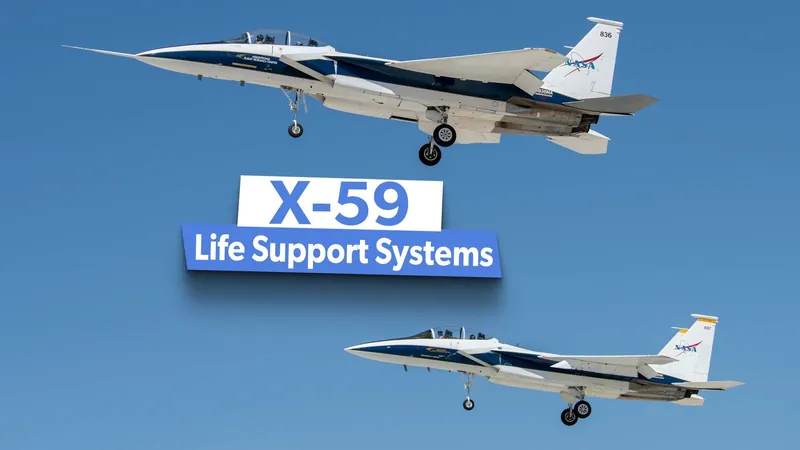
NASA's Ambitious Upgrades: F-15's New Life Support Systems Pave the Way for Supersonic Flight Testing of the X-59!
2024-12-29
Author: Rajesh
It’s been over two decades since the iconic Concorde, the supersonic passenger aircraft, last soared through the skies in November 2003. Although the Concorde isn’t the main topic of this article, its legacy continues to influence a groundbreaking experiment led by NASA in collaboration with Lockheed Martin. This innovative project, dubbed the Quiet Supersonic Technology Flight Demonstrator, aims to revolutionize air travel with the X-59 QueSST—a cutting-edge demonstration aircraft known for its unique design, which seeks to minimize sonic booms to a mere soft thump.
Understanding the Supersonic Challenge
One of the major hurdles faced during the Concorde's operation was the notorious sonic boom that accompanied supersonic flight. The noise pollution concerns rose sharply in the '70s, leading the Federal Aviation Administration (FAA) to impose strict regulations on supersonic travel over land. Although the Concorde managed to achieve non-stop flights between select international cities, the public’s unease regarding noise pollution ultimately hindered its profitability and scope of operations.
Despite the absence of supersonic passenger services in the United States for more than 21 years, there remains a robust appetite for fast air travel. The Concorde once slashed the New York to London journey to three hours—an enticing prospect for travelers who would be willing to invest more for such time-saving advantages.
The Promise of the X-59 QueSST
Recognizing the public’s lingering desire for supersonic transit, NASA and the FAA have been collaborating to explore the feasibility of integrating reduced-noise supersonic flight into the airspace system. The X-59 QueSST represents a pivotal step towards this goal, as it aims to fly at Mach 1.4—approximately 1,000 mph—at altitudes of 60,000 feet without producing disruptive sonic booms.
The flight tests will strategically take place to gather data on the sonic boom’s impact on communities from a distance of 11 miles away. To conduct this research effectively, NASA identified the F-15 as the ideal chase plane. Despite its capabilities, the F-15 needed significant modifications to ensure the safety of the pilots during high-altitude maneuvers.
Major Upgrades to Life Support Systems
A critical issue NASA encountered was the inherent hypoxia risk for F-15 crew members during extended missions at high altitudes. Hypoxia, the state of insufficient oxygen in the body, can severely impair pilot functionality, increasing the risk of accidents. While standard practice dictates that F-15 crews wear oxygen masks above the 8,000 ft pressurization level, hypoxia risks escalate beyond 40,000 ft.
To tackle this challenge, NASA opted to bolster the life support systems of the F-15. Research and insights led the team to adapt the advanced oxygen delivery system of the F-22 fighter jet—a system that had proven effective in addressing similar hypoxia issues. Upgrading the F-15 involved extensive engineering to seamlessly integrate this sophisticated technology.
Brian Griffin, the deputy operations leader for NASA’s Low Boom Flight Demonstrator Project, explained the endeavor: “Imagine breathing through an inflated balloon. If you don’t control the Positive Pressure Breathing system, the air will start to rush back into your lungs, complicating exhalation.” This illustrates the critical nature of optimizing the life support system for pilots flying at extreme altitudes where oxygen deprivation can happen quickly.
Thanks to these innovative advancements, the F-15 chase planes are now prepared for their role in the sonic boom research associated with the X-59 project.
What’s Next for the X-59 QueSST Project?
With extensive flight testing scheduled for mid-2025, if all goes well with the X-59's performance, sonic boom testing could begin in 2026. This new testing phase not only promises to unveil the potential of quiet supersonic travel but could also address public concerns regarding noise pollution, paving the way for a new era of aviation.
As anticipation builds for the future of supersonic flight, NASA's efforts in upgrading the F-15s underscore a critical shift in the way we perceive and utilize air travel. Stay tuned as this eagerly awaited technology evolves!

 Brasil (PT)
Brasil (PT)
 Canada (EN)
Canada (EN)
 Chile (ES)
Chile (ES)
 Česko (CS)
Česko (CS)
 대한민국 (KO)
대한민국 (KO)
 España (ES)
España (ES)
 France (FR)
France (FR)
 Hong Kong (EN)
Hong Kong (EN)
 Italia (IT)
Italia (IT)
 日本 (JA)
日本 (JA)
 Magyarország (HU)
Magyarország (HU)
 Norge (NO)
Norge (NO)
 Polska (PL)
Polska (PL)
 Schweiz (DE)
Schweiz (DE)
 Singapore (EN)
Singapore (EN)
 Sverige (SV)
Sverige (SV)
 Suomi (FI)
Suomi (FI)
 Türkiye (TR)
Türkiye (TR)
 الإمارات العربية المتحدة (AR)
الإمارات العربية المتحدة (AR)